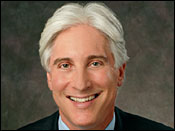雨滴
热爱生活和科学。
正文

Dr. Jonathan LaPook is the medical correspondent for the CBS Evening News with Katie Couric.
Yesterday's breakthrough in stem cell research was nothing short of spectacular. There are different types of stem cells and the most powerful ones, the ones that can develop into any of the approximately 220 cell types in the body have — until now — only been available by taking them from embryos left over from fertility clinics. Because the embryos are destroyed, the process has been the focus of intense ethical and political debate. Right now there is a government ban on creating any new embryonic stem cell collections. The few that already exist are old and not that useful.
Last year scientists figured out a way to take skin cells from mice and turn them into stem cells that are similar to the ones found in embryos.
How did they do this? It turns out that — by fiddling with their DNA — cells can be re-programmed to turn from a skin cell into a stem cell.
The scientists figured out they can give four genes (pieces of DNA) that tell a grown up skin cell to stop being a skin cell and turn into a stem cell. They splice those genes into the DNA of the skin cell with the use of a type of virus called a "retrovirus." Those genes turn the skin cells into stem cells in just 3-4 weeks!
We thought it was going to be a long time until they did this in humans but — amazingly — two different labs, one in Kyoto and one in Wisconsin, just announced they've done it. What's so surprising is that the recipe is relatively easy to follow. I expect there will be an explosion of stem cell research all over the world.
Why are stem cells important? When most people think about stem cells, they think about giving them to patients with diseases to help cure them. For example, in diabetes, stem cells might be able to turn into cells that make insulin — exactly the kind of cells that are missing in diabetic patients. This kind of therapy is a ways off. One reason is that the process by which the four genes are inserted into the DNA of skin cells causes those cells to be at increased risk to develop into cancer. Scientists are already working on ways around this problem.
But as soon as today, scientists can start using stem cells to learn more about diseases and to figure out new treatments. Take Alzheimer's disease.
We don't understand enough about what goes wrong in the nerve cells of patients with Alzheimer's. And you can't get brain cells from patients with Alzheimer's without taking the chance of hurting them. But now we can take skin cells from patients with Alzheimer's, turn them into stem cells, and then turn those stem cells into nerve cells. Next we can study those nerve cells in a Petri dish and try to figure out how they are different from the nerve cells in normal patients. And we can even try to test new drugs by squirting them on the nerve cells in the Petri dish — a lot safer then giving them to human guinea pigs.
The same thing goes for other problems like Parkinson's, ALS, diabetes, and heart disease. I just saw a movie of beating heart cells made from stem cells that started out as skin cells in a woman's face. Imagine squirting a new medicine right on the heart cells and seeing what happens.
This is the start of something very big. Compared to how we've been doing it up until now, I expect we'll now start learning about the inner workings of cells at warp speed.
And the faster we figure out what's going on inside the cells of people with diseases, the faster we can devise ways to cure them. But none of this will happen without adequate funding and support from the government. I would bet my last dollar on the ingenuity, intelligence, and perseverance of the scientists around the world who are dedicating their lives to medical research. Last Sunday I called a young stem cell researcher with a question and found him hard at work in his lab. But right now too many labs are struggling for adequate funding and too many researchers are living on a shoestring budget, trying to make ends meet. It is simply unacceptable. This latest breakthrough should spur us all to call for increased support of our medical research community.
评论
目前还没有任何评论
登录后才可评论.




